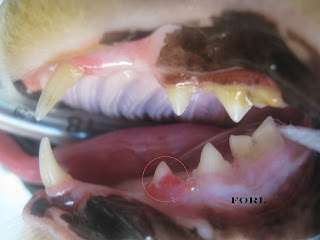| Furla |
I have a few soapboxes that I like to stand on when it comes
to advice on how to take care of your pet. Coming in at the top of the list are the importance of
spay/neuter, keeping your dog from getting heat stroke and dental disease. Imagine my horror when
I discovered that my own kitty Furla had a grade three FORL!
FORL, which stands for feline odontoclastic resportive
lesion is a condition that appears to be unique to cats. The lesions are similar to human
cavities in that there is a defect in the enamel of the tooth and it is very
painful. If your cat is over the
age of 5 years old then there is a 72% chance a FORL is present. As with all
dental disease, FORLs can lead to increased bacteria circulating in the blood
stream resulting in liver, kidney and heart disease.
 |
| Furla's teeth before cleaning |
These nasty FORLs are usually found along the outer surface
of the tooth where it meets the gum line.
They can present in many stages requiring dental radiographs to
determine if the tooth root is involved.
At the beginning stage an enamel defect is present which then progresses
as the FORL penetrates the enamel and invades the pulp cavity, they appear as
pink or red defects in the tooth where it meets the gum. As the lesion develops it becomes
increasingly more painful for your cat.
Treatment entails a full dental exam under anesthesia and surgical
extraction of the offending tooth.
Every few months (I should do it monthly…) I check all my
animal’s teeth to look for any signs of dental disease. Usually with FORLs you can see clinical
signs such as difficulty eating, drooling, bleeding along the gums and dropping
food from the mouth. However, some
cats like Furla to not show any signs at all. At eight years old overall she had lovely teeth with minimal
tartar and gingivitis – except for that nasty, painful FORL.
As I managed my feeling of guilt for neglecting one of my
animals I immediately scheduled a dental to address the issue. Here is where it gets even worse – they
found a second FORL that had completely resorbed which means it had been there
for a while. They also found she
had a dead tooth that needed to be extracted. This is the perfect example of dental disease that is
lurking under the gumline and cannot be found without a full dental exam under
anesthesia.
 |
| X-rays showing Furla's FORL and tooth root abscess |
Furla seemed unfazed by her dental and having two teeth
extracted, she was happily snacking on canned food a few hours after she woke
up from anesthesia. I have
certainly learned my lesson and I hope this serves as a cautionary tale for all
pet owners about the important of checking your cat’s teeth regularly. Finding and treating these lesions
early will result in a healthier, happier kitty.
| Furla and Poppy taking a break |








No comments:
Post a Comment